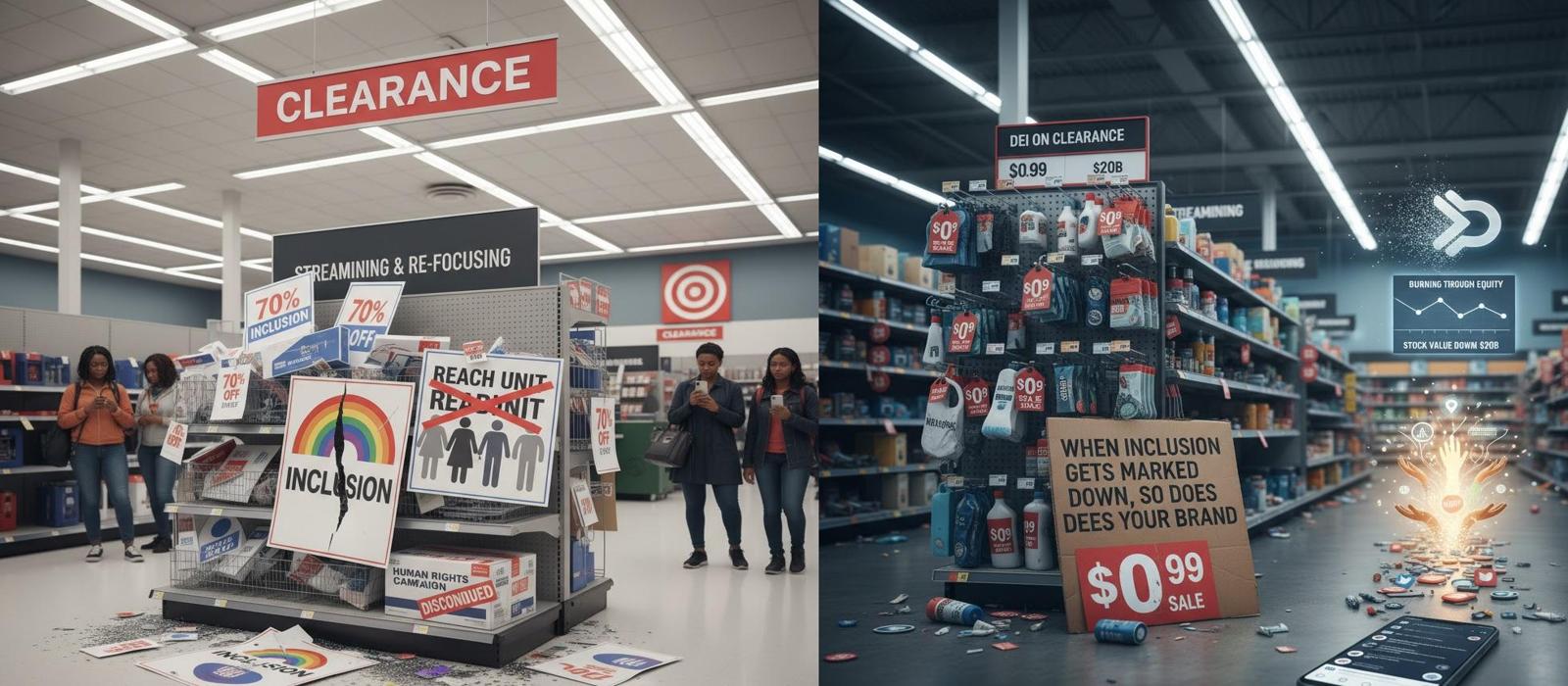
Some brands are quietly taking down their diversity signs. The language of “inclusion” that was once the heart of their press releases has been pushed into the clearance aisle, tucked behind new corporate buzzwords like “streamlining” and “re-focusing.” It’s a retreat disguised as strategy. But make no mistake: when a brand rolls back DEI, it isn’t just trimming costs, it’s burning through equity.
When Target announced in early 2025 that it would dissolve its REACH (Racial Equity Action & Change) unit and step away from the Human Rights Campaign’s Corporate Equality Index, it signalled much more than a shift in staffing. The immediate fallout was brutal: one report estimates that by mid-September, the company had lost more than $20 billion in market value following the rollback of its DEI commitments. Store traffic plummeted for ten weeks straight, and social-listening platforms registered negative sentiment at roughly double positive mentions in the immediate weeks. That is not a simple brand glitch. It is a cultural collapse.
Culture doesn’t wait for the boardroom. It doesn’t taper off when earnings season arrives. Instead, it ripples through group chats, creator networks, TikTok trends, and forums, often two steps ahead of any internal memo. When a brand takes its foot off the inclusion pedal, it doesn’t drift toward neutrality; it reverses straight into irrelevance. Communities, creators, and the platforms they use all notice.
The bigger problem? The data still backs inclusion—even as corporate appetite for it wanes. According to a 2024 report, 66 % of Black consumers say they are willing to cut ties with brands that they feel devalue their community. Meanwhile, nearly 70% of Black consumers and more than half of Asian, Hispanic, and Latinx consumers say it is important that creative work is produced by diverse teams. That’s not a nicety; it’s a business imperative. Treating inclusivity as optional becomes a strategic misstep, not a moral choice.
Inclusion is not a seasonal initiative; it’s an operating system. It’s the infrastructure behind authentic storytelling, sustained loyalty, and brand credibility. Pulling it apart to appease fear or headlines is like removing a car’s engine because you think the color is outdated. The idea that you can quietly pause equity work and still maintain cultural trust is corporate delusion. Once you’ve told people they matter, you cannot un-tell them, and if your silence speaks louder than your actions, the market listens.
This moment is especially stark because the backlash isn’t just coming from outside of the house. It’s internal, digital, and deeply immersive. The backlash against Target became one of the most sustained brand crises in recent memory: over 200 days of organized boycott, months of declining traffic, and one of the fastest ascents into mainstream cultural critique. The “quiet” DEI retreat has emerged as its own brand-risk category: when brands stop promising equity, we often don’t stay quiet ourselves.
But even as some companies retreat, others are quietly showing that inclusion done right isn’t fragile—it’s foundational. When brands embed and embrace equity, they don’t just avoid crisis—they unlock growth. Brands like Hyundai that kept investing in multicultural outreach, community partnership, and inclusive marketing won attention and built trust. Representation then becomes a strategic advantage, not a marketing checkbox.
The irony of it all is that writing off DEI doesn’t reduce risk—it increases it. The multicultural marketplace is not a side channel: it accounts for over 40 % of U.S. spending growth and a major portion of cultural influence. Ignoring that doesn’t hide you from the storm; it puts you directly in its path. Running on outdated segmentation means you miss how culture organizes consumers today: by values, identity, network, not just ZIP code.
Brands that treat DEI as expendable are losing credibility, and they’re misreading the entire economy. They’re confusing fatigue with passivity. The truth is harsher: audiences aren’t indifferent—they’re selective. They want depth, not performance. They care about meaning, not messaging. And the brands that understand that will own the next decade of connection. And connection is the name of the game.
So when executives talk about “refocusing” or “streamlining” inclusion programs, let’s be clear about what that means. It means stepping back from the very people who built your relevance. It means shifting from participation to exclusion. It means betting on silence when people expect to be heard. In 2025, inclusion is the bare minimum, not an asset that’s just nice to have. Because if culture is the strategy, erasure is the risk.
When brands put DEI on clearance, culture does too, and culture always writes the scoreboard.